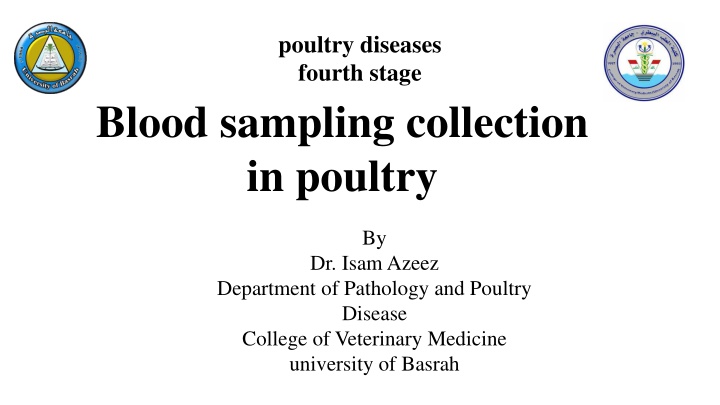
Collecting Blood Samples from Poultry: Methods and Importance
Learn about the significance of blood sampling in poultry, including reasons for collection, types of samples, necessary equipment, blood collection sites, and optimal blood volume. Understand the process for collecting blood from poultry as a critical diagnostic tool for flock health monitoring and disease detection.
Download Presentation

Please find below an Image/Link to download the presentation.
The content on the website is provided AS IS for your information and personal use only. It may not be sold, licensed, or shared on other websites without obtaining consent from the author. If you encounter any issues during the download, it is possible that the publisher has removed the file from their server.
You are allowed to download the files provided on this website for personal or commercial use, subject to the condition that they are used lawfully. All files are the property of their respective owners.
The content on the website is provided AS IS for your information and personal use only. It may not be sold, licensed, or shared on other websites without obtaining consent from the author.
E N D
Presentation Transcript
poultry diseases fourth stage Blood sampling collection in poultry By Dr. Isam Azeez Department of Pathology and Poultry Disease College of Veterinary Medicine university of Basrah
Why do we collect blood samples from poultry? 1- to determine the cause of morbidity and mortality in your flock. 2- monitoring flock health can be achieved by monitoring the condition of the erythrocytes (red blood cells), leukocytes thrombocytes (platelet-type cells). 3- determine immunity level and disease exposure: Serum samples are used by the veterinarian to obtain antibody titer levels. (white blood cells), and
Types of blood samples 1-Whole blood samples: are usually used by the veterinarian or flock specialist to examine, by microscopy, the condition of the erythrocytes (red blood cells), leukocytes (white blood cells), and thrombocytes (platelet-type cells). 2-Plasma samples: are often used by the veterinarian to obtain the chemical profile of the bird s blood. 3-Serum samples: are used by the veterinarian to obtain antibody titer levels present to determine flock exposure to disease agents.
What Will You Need to Collect Blood? 3 mL syringes (1 mL = 1 cc) Needles (the higher the gauge, the smaller the diameter of the needle). Blood collection vials Mini cooler (for transportation of blood samples to the laboratory) .Cotton wool .Alcohol solution .Labels or marking pen to label each syringe.
How Much Blood Can One Collect? The amount of blood that can be safely collected from a clinically healthy bird is 1% of its bodyweight, in grams. For example, the maximum amount of blood to take from a 500 g bird is 5 mL (5 cc) of blood.
Where Are the Blood Collection Sites? 1-The large vein under the wing (brachial vein). . 2-jugular vein. 3-medial metatarsal vein. 4-Heart.
The large vein under the wing (brachial vein) Place the bird on a table, setting it on its side. Lift up the wing with one hand and part the feathers along the wing. Water can be used to help keep the feathers separated. Place the needle at a slight angle, bevel up against the vein on the underside of the wing. .The bevel end is the side of the needle with the angle and the hole. Insert the needle into the vein and slowly withdraw blood. .Remove the needle and apply pressure to the vein for a few seconds
methods of blood collection from the domestic chicken The large vein under the wing Medial metatarsal vein
jugular vein. Heart.
